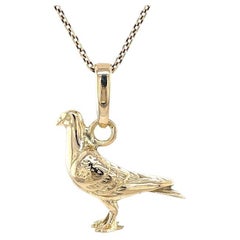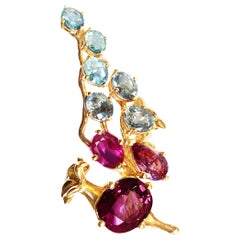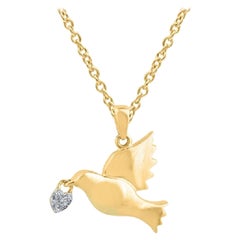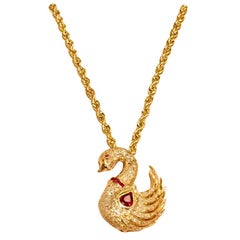Pigeon 14k Pendant
21st Century and Contemporary Contemporary Pendant Necklaces
14k Gold, Yellow Gold
21st Century and Contemporary German Contemporary Pendant Necklaces
Rubelite, Ruby, Sapphire, Blue Sapphire, Green Sapphire, Tourmaline, Par...
2010s Indian Pendant Necklaces
Diamond, Yellow Gold, 14k Gold
Recent Sales
Late 20th Century American Contemporary Brooches
White Diamond, Ruby, 14k Gold, Yellow Gold
People Also Browsed
2010s Pendant Necklaces
Diamond, Ruby, 18k Gold, White Gold
The Legacy of Diamond in Jewelry Design
Antique diamond rings, diamond tiaras and dazzling vintage diamond earrings are on the wish lists of every lover of fine jewelry. And diamonds and diamond jewelry are primarily associated with storybook engagements and red-carpet grand entrances — indeed, this ultra-cherished gemstone has a dramatic history on its hands.
From “A Diamond Is Forever” to “Diamonds Are a Girl’s Best Friend,” pop culture has ingrained in our minds that diamonds are the most desired, the most lasting and the most valuable gemstone. But what makes the diamond so special? Each stone — whether it’s rubies, sapphires or another stone — is unique and important in its own right. April babies might claim diamonds for themselves, but just about everyone wants this kind of sparkle in their lives!
There are several factors that set diamonds apart from other stones, and these points are important to our gem education.
Diamonds are minerals. They are made up of almost entirely of carbon (carbon comprises 99.95 percent; the remainder consists of various trace elements). Diamonds are the hardest gemstones, ranking number 10 on the Mohs Hardness Scale. Even its name, diamond, is rooted in the Greek adamas, or unconquerable. The only object that can scratch a diamond is another diamond. Diamonds are formed deep within the earth at very high temperatures (1,652–2,372 degrees Fahrenheit at depths between 90 and 120 miles beneath the earth’s surface) and are carried up by volcanic activity. Diamonds are quite rare, according to the Gemological Institute of America, and only 30 percent of all the diamonds mined in the world are gem quality.
In the 1950s, the Gemological Institute of America developed the 4Cs grading system to classify diamonds: clarity, color, cut and carat weight. Not all diamonds are created equal (there are diamonds, and then there are diamonds). The value of the diamond depends on the clarity (flawless diamonds are very rare but a diamond's value decreases if there are many blemishes or inclusions), color (the less color the higher the grade), cut (how the diamond’s facets catch the light, certain cuts of diamonds show off the stone better than others) and carat weight (the bigger, the better).
When you start shopping for a diamond engagement ring, always prioritize the cut, which plays the largest role in the diamond's beauty (taking the time to clean your diamond ring at least every six months or so plays a role in maintaining said beauty). And on 1stDibs, a range of buying guides can be found for those in the market for antique engagement rings, vintage engagement rings or Art Deco engagement rings.
Shop antique and vintage diamond rings, diamond necklaces and other extraordinary diamond jewelry on 1stDibs.
Finding the Right Pendant-necklaces for You
Whether you’re layering multiple jewelry pieces or opting for a single strand, vintage pendant necklaces are versatile accessories that can elevate your casual wear as easily as they can add a creative flourish to your formal attire.
The earliest jewelry was less about accessorizing than it was about wearers arming themselves with amulets. In Ancient Egypt, some amulets featured a loop so that they could be strung around one’s neck. While rubies have long been one of the few gemstones that can give diamonds a run for their money, members of some ancient civilizations valued the stones from the get-go, donning ruby pendants as well as other stones with the belief that these adornments would bring protection, healing powers or strength. Today, we still wear our charm bracelets and charm pendants around our necks for good luck.
Later, pendant necklaces, like most fine jewelry, were worn strictly by royalty or the upper class and conferred wealth and prestige. This changed over time, thankfully, as wearing jewelry became more widespread, a democratized means of personal expression.
During the 18th and 19th centuries, pendant necklaces evolved from their status as spiritual amulets, but the jewels still carried deep personal significance. Victorian pendants, in particular, were part of the “mourning jewelry” tradition. Wearers would embed their pendants with locks of hair from a deceased loved one as a way of grieving in the wake of a loss. In the case of cameo jewelry, some pendants were even decorated with miniature hand-carved portraits in a detailed raised relief. Today, portraiture is still a characteristic of many of the hand-carved pendant necklaces offered by Italian jewelry house Scala Gioielli.
Luxury fine jewelry brands such as Cartier, BVLGARI and David Yurman offer their own unique interpretations of the cherished accessory, embellishing platinum or gold pendant necklaces with diamonds, sapphires and other stones.
On 1stDibs, find an extraordinary range of vintage pendant necklaces and other necklaces today.
- What is 14K gold?1 Answer1stDibs ExpertFebruary 1, 2024The term 14K gold, or 14-karat gold, refers to a type of gold alloy. The term alloy means a metal made of two or more base metals. In the case of 14-karat gold, 58.5% of the content is pure gold, and the remaining 41.5% is alloy metal. Due to the strength of the metal, many jewelry makers use 14-karat gold in their pieces. Find a wide variety of 14-karat gold jewelry on 1stDibs.
- What is the meaning of 14k?1 Answer1stDibs ExpertOctober 5, 202114K or 14-karat gold is produced using 58.3% pure gold with a 41.7% mix of various metals such as zinc, nickel or silver. It has only 14 parts of 24 that are real gold, which makes it more affordable. Find a collection of 14K gold chains, pendants, necklaces and much more on 1stDibs.
- 1stDibs ExpertNovember 20, 2024The difference between 14K gold and 14K Italian gold is the place of production. Both types of jewelry feature 14-karat gold, an alloy that is 58.3% gold and 41.7% alloy metals. However, Italian gold pieces come specifically from artisans, workshops and factories located in Italy. You can find 14-karat gold made in many other countries. Shop a diverse assortment of gold jewelry on 1stDibs.
- What does 14K earrings mean?1 Answer1stDibs ExpertNovember 6, 2023The term "14K earrings" means a pair of earrings that feature 14-karat white, yellow or rose gold. To be labeled 14-karat, a gold alloy must consist of 14 parts gold and 10 parts base metal. This means that 58.3% of the alloy is gold, and 41.7% consists of other metals. Find a wide range of gold earrings on 1stDibs.
- 1stDibs ExpertNovember 21, 2023Whether a wedding band should be 14K or 18K depends on your personal preferences. Because it contains more pure gold, 18-karat gold will usually show off a richer color and be less likely to fade over time. On the other hand, 14-karat gold is less prone to scratching and damage because it has more alloy metals. Explore a large collection of gold wedding bands on 1stDibs.
- 1stDibs ExpertFebruary 27, 2024The difference between 10K and 14K gold is how much of the metal's content is pure gold versus alloy metal. 14K gold is 58.3% pure gold and 41.7% alloy, while 10K gold is 41.7% pure gold and 58.3% alloy. Due to the increased amount of alloy metal, 10K gold tends to be stronger than 14K. On the other hand, the increased gold content of 14K gives the metal a richer color and a generally higher value. Explore a large collection of gold jewelry on 1stDibs.
- 1stDibs ExpertOctober 12, 2021The difference between 14k and 18k rose gold metal is that the 14k rose gold is less pure than 18k. 14k rose gold has a deeper pink color because of greater amounts of copper, whereas 18k rose gold has 75% gold and appears yellow. 14k rose gold is increasingly popular due to its brighter pink hue and resistance to scratches. On 1stDibs, shop a range of vintage rose gold jewelry.
- Are 14K gold earrings good?1 Answer1stDibs ExpertNovember 6, 2023Yes, 14-karat gold earrings can be good. One of the biggest benefits of 14-karat gold is that the base metal content provides added strength, helping earrings resist scratching and damage. The downside to 14-karat gold is that its color often isn't as rich as purer alloys like 18- and 22-karat gold. On 1stDibs, shop a large selection of gold earrings.
- Is 14K gold good for earrings?1 Answer1stDibs ExpertNovember 1, 2023Yes, 14k gold can be good for earrings. The precious metal is rich in color, making it an appealing choice for jewelry. It is also durable and reasonably priced compared to 18-karat gold. The biggest downside to 14-karat gold earrings is that they contain a larger percentage of base metals than 18-karat and may be more likely to cause sensitivity reactions in some people as a result. Explore a large selection of gold earrings on 1stDibs.
- 1stDibs ExpertSeptember 28, 2021The value of a 14K gold bracelet is going to depend on condition and other factors. Because gold is traded on the stock market, its value fluctuates. 14K gold is a gold alloy that contains more than 58% pure gold. That said, 14K gold is worth 58.5% of the price of whatever 100% pure gold may be worth on a given day. Find a range of 14K gold jewelry today on 1stDibs.
- What is a 14k gold-filled watch?1 Answer1stDibs ExpertNovember 22, 2024A 14-karat gold-filled watch is a watch made primarily out of base metals and then finished with a thin layer of gold. The term 14-karat refers to a gold alloy that is 58.3% pure gold and 41.7% other metals. Compared to solid gold watches, gold-filled timepieces are typically more accessibly priced. On 1stDibs, shop a diverse assortment of gold watches.
- Is 14k solid gold real?1 Answer1stDibs ExpertMarch 13, 2024Yes, 14k solid gold is real. However, it is not pure gold. The term 14-karat describes gold, which is 58.3% pure gold and 41.7% alloy metal. Adding alloy metal helps to make the gold more resistant to wear and tear. On 1stDibs, explore a diverse assortment of 14k gold jewelry.
- Is 14K gold okay for earrings?1 Answer1stDibs ExpertNovember 27, 2023Yes, 14K gold is okay for earrings. In fact, many people opt for earrings crafted out of 14-karat gold. This type of gold is 53.8% pure gold and 41.7% alloy. The high content of base metals makes 14-karat gold strong enough to resist scratches, so earrings made from the precious metal can hold up to the effects of daily wear. Shop a diverse assortment of 14-karat gold earrings on 1stDibs.
- Is 14K MEX real gold?1 Answer1stDibs ExpertOctober 15, 2024Yes, 14K MEX may be real gold. The MEX marking indicates that the piece comes from a factory or workshop in Mexico, while the 14K hallmark means that it is 14-karat gold, an alloy of 58.5% pure gold and 41.4% base metal. However, counterfeiters do sometimes place fraudulent hallmarks on jewelry made of less expensive materials. If you suspect your jewelry may not be genuine, you may wish to have a certified appraiser or knowledgeable jeweler evaluate it for you. Shop a wide variety of gold jewelry on 1stDibs.
- 1stDibs ExpertSeptember 9, 2024How much your 14-karat gold chain is worth depends on a variety of factors. In terms of value as scrap metal alone, the length and thickness of the chain will affect how much gold it contains, contributing to its value. Some chains may be worth more due to their maker, style, type, condition and other factors. A certified appraiser or experienced jeweler can give you an idea of how much a particular chain may be worth. On 1stDibs, shop a selection of 14-karat gold chains.
- 1stDibs ExpertOctober 12, 2021How much a 14k gold necklace should cost will depend on its value on the precious metals market, as it changes every day. The average cost of 14k gold should be around $31 according to the market for gold. A 14k gold necklace’s value will depend on craftsmanship, origin, condition and other factors that include the market price. Find antique and vintage gold necklaces on 1stDibs.
- Did Cartier ever use 14K gold?1 Answer1stDibs ExpertApril 5, 2022No, Cartier is known for only using 18k gold in their products, as well as platinum. Their attention to quality in materials and workmanship have contributed to their reputation for luxury. Shop an array of authentic gold and platinum Cartier pieces on 1stDibs.
- 1stDibs ExpertAugust 26, 2024To tell if a 14K gold necklace is real, place a magnet on it. If you notice a strong attraction, the piece is unlikely to be genuine 14-karat gold because the gold alloy is not magnetic. A certified appraiser or experienced jeweler can also help you assess whether your piece is real gold. Find a wide variety of gold necklaces on 1stDibs.
- 1stDibs ExpertFebruary 22, 2021The value of a 14k gold chain is dependent on its weight, craftsmanship, brand name, condition and the market value of gold. The gold price per gram fluctuates but it was approximately $61 in early 2021. On 1stDibs, you can purchase a 14k gold chain at a variety of price points.
- 1stDibs ExpertOctober 30, 2024Yes, your 14K gold necklace may be worth something. Because it contains some pure gold, your necklace can likely be sold for scrap metal. How much you can expect to receive for it will depend on its weight and the current market conditions. Your necklace could potentially have value beyond the going price for 14-karat gold, depending on its age, style, maker, condition and other factors. A certified appraiser or knowledgeable jeweler can give you an idea of how much your piece may be worth. On 1stDibs, shop a large collection of gold necklaces.
Read More
This Victorian Necklace Features a Rainbow of Gems
If jewelry could talk, we know this piece would have good stories.
A Centuries-Old Style, Lockets Have Never Lost Their Romantic Appeal
Emblems of heartfelt emotion, elegant vessels for photos and keepsakes and perfect for layering, these special ornaments are an essential component of any thoughtfully curated jewelry collection.
This Van Cleef & Arpels Necklace Is an Heirloom in the Making
With more than 100 carats of diamonds, this vintage stunner converts into different styles, making it as versatile as it is breathtaking.
[Survey] Two-Thirds of Jewelry Gift Recipients Don’t Want to Be Surprised
Givers of fine gems enjoy surprise more than receivers, and women more than men. Find out what else our survey of 3,000 Americans revealed.
Next-Level Pearls That Go Well Beyond the Expected
Organic shapes, surprising textures, shimmering colors and inventive embellishments take the new generation of pearl jewelry from classic to cutting-edge.
7 Vibrant Jewels for a Breezy Late-Summer Wardrobe
Soak up the pleasures of the season with a these bold gems.
Whether Worn Alone or Layered, These Chain Link Necklaces Are Trending
Learn more about the stylish links that have passed the test of time.
Meet the Dapper, Mustachioed Parisian Who’s Tops in Crafting Enticing Jewels
After more than a decade creating the iconic Lanvin gems of the Alber Elbaz years, designer Elie Top dove into the world of fine jewelry, mixing silver and gold to create his own striking, timeless look.



